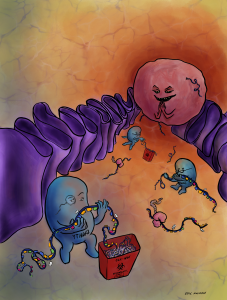It turns out that the “burn after reading” strategy doesn’t just apply to the secret messages (and not-so-secret memoirs) of CIA analysts, it also helps keep cancer cells alive. In a new study, the lab of Gene Yeo at UCSD deciphered key vulnerabilities in a cancerous network, highlighting a role for the m6A mRNA reader YTHDF2 in sustaining MYC-driven breast cancer.
Although MYC-driven tumors rely on hyperproduction of oncogenic proteins, these cancer cells must keep such hyperproduction in check through a constellation of RNA-binding proteins (RBPs) that regulate mRNA turnover to prevent a lethal protein logjam. In order to crack the code of this network, the talented team applied a synthetic lethality CRISPR screen of 1078 RBPs to human mammary epithelial cells (HMECs) with tamoxifen-induced MYC activity. This revealed 57 candidate proteins required for cancer cell survival, enriched for proteins involved in modulating RNA turnover by reducing the stability of transcripts for translation. YTHDF2 was identified as a prime suspect, since it shuttles m6A mRNA to processing bodies, and recruits the deadenylation complex (CCR4-NOT) to initiate degradation of these transcripts.
The team followed up on their screen with strategic functional strikes, where they found that:
- Knocking down both YTHDF2 and m6A writer METTL3 with shRNA in MYC-induced HMECs increases apoptosis
- Depletion of YTHDF2 results in decreased tumor size upon engraftment into mice
- Full body knockout mice lacking Ythdf2 exhibit no deleterious secondary effect on non-tumor tissue
The team then leveraged the extensive patient data stored in The Cancer Genome Atlas (TCGA) to translate their experimental results, finding that:
- Two thirds of candidate RBPs uncovered by the screen exhibit elevated expression levels in MYC-amplified triple-negative breast cancer (TNBC) tumors
- Overall survival is higher in patients with tumors expressing lower levels of YTHDF2 as well as other mRNA degradation factors
It is clear that YTHDF2’s clearance of m6A-altered transcripts plays an important role in these cancers, but how does shredding these compromising transcripts ultimately relate to protein levels? Einstein et al. determined that YTHDF2-depleted cells experience higher levels of protein translation, according to both puromycin incorporation and scRibo-STAMP, a new assay out of the Yeo Lab. Furthermore, scRibo-STAMP data indicates that differentially translated genes in YTHDF2-depleted tumor cells are enriched for both apoptotic and tumorigenic transcripts.
In summary, YTHDF2 helps regulate the degradation of transcripts relevant to tumorigenic pathways. Although the proteins encoded by these genes are vital to cancer progression, YTHDF2 acts as the cancer cells’ cleanup crew to ensure they don’t generate too much of a good thing (for the cancer cells, that is). First author Jaclyn Einstein concludes that, “The results from our study are quite exciting because they highlight the potential for targeting a previously overlooked class of proteins in disease.”
Go make sure that this message doesn’t get lost in translation over at Molecular Cell, July 2021.


